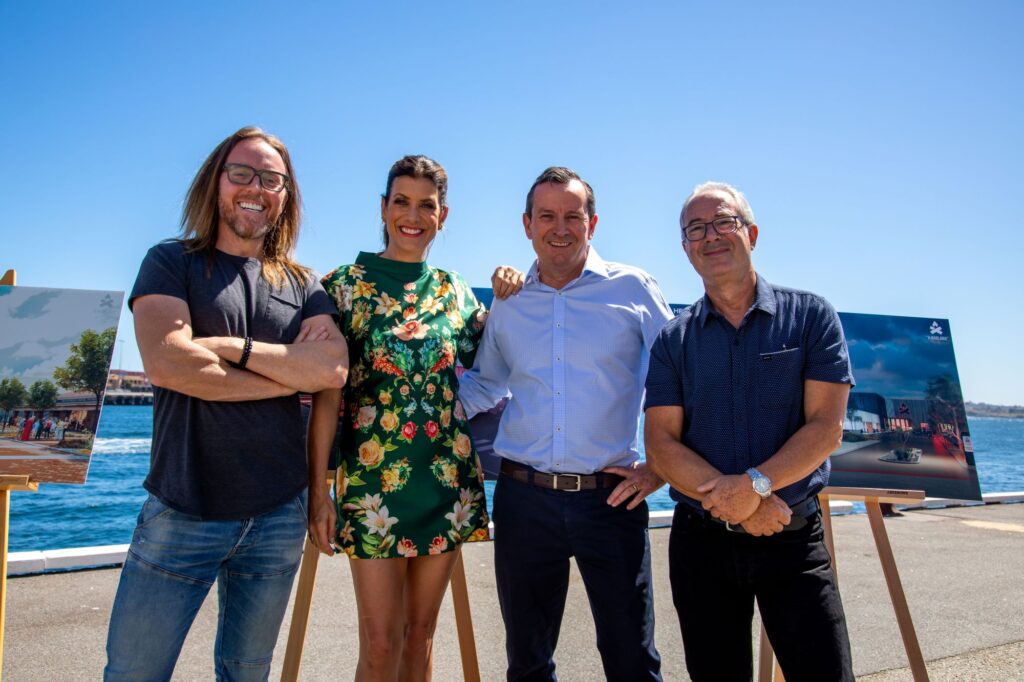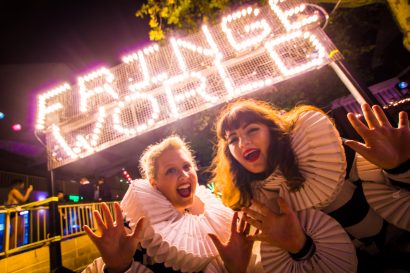The long-held dream of a movie studio in Western Australia is edging closer to reality. But is a $100 million state-of-the-art facility on Victoria Quay what our screen industry needs, asks Mark Naglazas in the first in a series on the most important piece of infrastructure in the State’s film and television history.
Hollywood or bust?
6 May 2021
- Reading time • 10 minutesFilm
More like this
- The great unknown
- Darkness lights the way
- Shining a beacon of light on our history
Western Australia has long seen itself as the new Hollywood. We have the sunshine and the space, we have the talent and tenacity (Judy Davis, Heath Ledger, Sam Worthington and Isla Fischer all began their careers here) and we boast an internationally renowned drama academy whose graduates include Hugh Jackman, Frances O’Connor and Tim Minchin. The only thing holding us back, claim those dreaming of Hollywood on the Swan, is the lack of a movie studio.
It’s not enough to have big blue skies and stunning landscapes, argues the 2020 Screenwest Infrastructure Report. If the industry is to benefit in the explosion in production in Australia and globally, we must plug the talent drain and lure the kind of big-budget extravaganzas that have been snapping up studio space in Sydney, Melbourne, the Gold Coast and Adelaide with a sizeable sound stage and adjacent infrastructure and facilities.
Over the decades there’s been numerous attempts to turn that dream into realty. In the early 1990s the Lawrence Labor government declared its intention to build a film centre on the site of the former WestEd Media in Leederville; in 2013 there was fanciful push for a studio at Murdoch University; and two heritage sites, the Midland Railways Workshops and Sunset Hospital, have been regularly used for film and television production and touted as possible permanent locations.
Things got serious last year when the McGowan Government announced it was seeking proposals from the private sector to build and operate a film studio. To ensure its success the government committed an extra $20 million on top of the $100 million for the facility to attract the Marvel-level productions that would be necessary to sustain an operation of this ambition and scale.
What sparked the state government into action was COVID. With film-making facilities in Hollywood and around the world shut down because of the pandemic producers started making a beeline for Australia, encouraged by a $400 million grant by the federal government to attract overseas productions.
A movie studio also chimes with the government’s plan to use the creative sector to diversify the economy. All around the world the digital industries are being pushed along by a COVID-fuelled boom, from gaming to streaming to virtual reality, so a high-end movie studio will allow us to catch the wave and lessen our reliance on mining and agriculture.

In February the government announced its preferred bidder to develop and operate the studio was Home Fire Creative Industries, a consortium which includes property developer Adrian Fini and his Little Creatures partner Howard Cearns, former ScreenWest CEO Ian Booth and producer Jamie Hilton, and the site would be Fremantle’s Victoria Quay. Their main competition was a group seeking to take over a City of Fremantle-owned industrial site in Jones Street, O’Connor.
The choice between the two proposals was striking. The O’Connor proposal was modestly budgeted, could be acted upon quickly to take advantage of the COVID-created content gold rush and was more scaled to the needs of the local industry; Home Fire Creative Industries’ stunningly ambitious idea is to build a world-class high-tech facility in the heart of Fremantle that would be woven into the arts and entertainment and tourism fabric of the port city.
While the local film industry is thrilled with the McGowan Labor government’s $120 million commitment to infrastructure and production, questions are being asked about the viability of sustaining such a facility, the suitability of Victoria Quay as a location and the benefits for the local screen industry.
Build it and they will come. Perhaps.
While film and television production is booming in Australia – barely a week passes without the news of a new superstar arrival – maintaining a film studio over the long run is notoriously difficult according to Sue Taylor, one of WA’s most experienced and respected producers (The Tree Looking for Grace, Three Summers).
“Studios are geared toward attracting international productions and that is dependent on the strength of the Australian dollar,” says Taylor. “All countries around the world are offering subsidies so our dollar in relation to the American dollar will determine if a production comes here. At the moment COVID is the new X-factor but that won’t be relevant when our studio is up and running.”
A striking example of the risks is Melbourne’s Dockland Studios, which struggled so much in initial years and was even dubbed a white elephant. There were periods of many months when the studio lay empty and the local industry were angry that millions of tax-payers dollars that were being used to prop up the facility could have been better spent on homegrown films.
Despite her concerns Taylor says the state government’s willingness to not just build a studio but inject the money needed to make it work presents the industry with a significant opportunity. She also believes the government made the right decision in choosing the attention-grabbing Home Fire Creative proposal.
“If you’re going to build a studio – and new infrastructure is always a wonderful thing – then you have to go hard and go big. You’re not going to attract the Netflixes of this world with a small hub tucked away in a corner. And the government appears to be committed to making the studio work.”
“And one of the hardest things about putting together a production is attracting actors. So offering to put them up in a beautiful place like Fremantle is a huge plus. And by keeping the studio at the centre of the public’s imagination will secure the support of the government and the public, which will be essential to sustain it.”
Screen Producers Association CEO Matthew Deaner agrees with Taylor that it is an enormous challenge to maintain a studio geared toward luring Hollywood productions.
“It has to be done with care,” warns Deaner. “You have to go in with a full sense of what is happening or you can get it quite wrong. And it is not a COVID puppy that you get rid of after a couple of years. You have to have a long-term approach and it needs a deep commitment from government.”
However, Deaner believes that if you get it right the benefits for the local industry are enormous. “A studio can have a halo effect for the whole sector and way beyond. It can elevate a city in the way a new football stadium does. And when actors go on a US talk show and gush about how amazing it was to shoot in Perth that is of enormous value,” says Deaner.

A clear benefit of a world-class facility in Fremantle is that it will prevent productions getting away from us – Grant Sputore’s celebrated sci-fi thriller I Am Mother had to be shot in Adelaide because our existing studio spaces are too small – but stop the talent drain.
Filmmakers such as Sputore, Ben Young (Hounds of Love) and Zach Hilditch (These Final Hours, 1922) are now working at an international level, which means that without a studio they will take their projects elsewhere or not encourage their producers to work in their hometown. It would also potentially prevent crews aspiring to work at a higher level from taking off to the east coast or Hollywood and never returning.
And then there’s the recent example of Perth-based Simon McQuoid, an internationally renowned commercials director who recently made his feature film debut with Mortal Kombat, which was shot at the Adelaide Studios. Perth did not lose that project – we were never in the running – but if there was a world-class studio here it is reasonable to assume McQuoid would’ve offered up Perth to the film’s producer, action-fantasy maestro James Wan (Fast and Furious 7, Aquaman) who, in Hollywood-ish twist, is also from Perth.
McQuoid told The Subiaco Post that a production of the scale of Mortal Kombat injects millions into the local economy and creates hundreds of jobs. “You have to have a sound stage,” he said. “Once the new one in Fremantle is built and that box can be ticked it will be a game changer.”
Seesaw’s three-part series on the proposed Fremantle film studio continues next week with “Lights! Cameras! Fremantle!” Is a filmmaking facility in the middle of a working port and a tourist centre the best choice?
Pictured top: An artist’s impression of Home Fire Studios, the film studio proposed for Victoria Quay Fremantle. Photo supplied
Like what you're reading? Support Seesaw.






